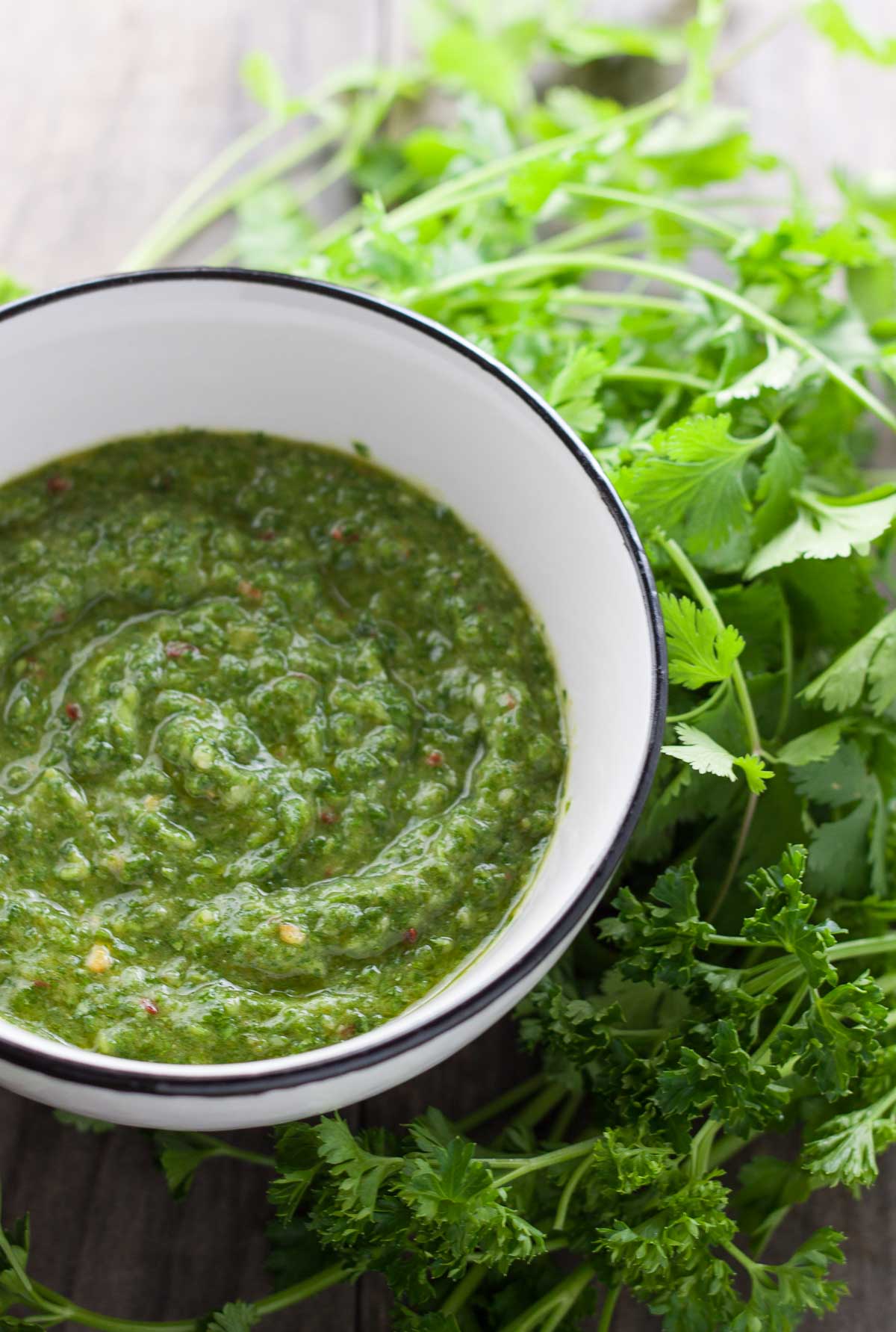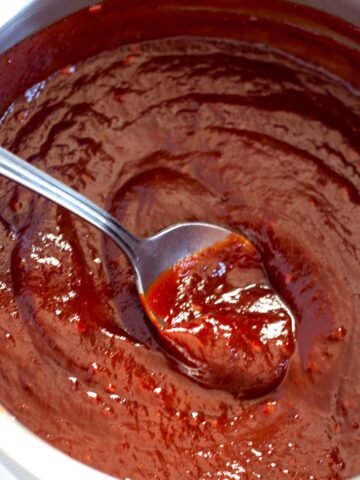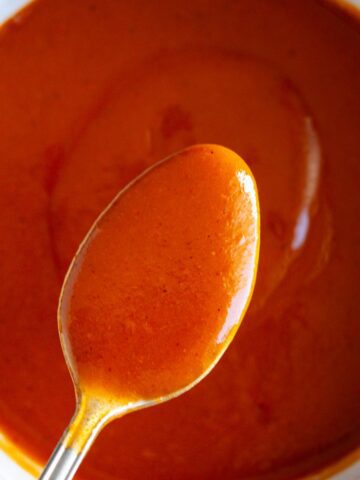Fresh, herbaceous, and just begging to be served on top of grilled steak and other proteins, this easy Chimichurri sauce features roasted garlic for a lovely twist on a classic garlic-forward chimichurri sauce.
AND this is a parsley chimichurri - no cilantro! (Though I include instructions on how to include cilantro if you'd prefer its inclusion in this sauce).

Chee-mee-CHOO-ree! It’s as fun to say as it is delicious to eat. And if I do say so myself, this easy chimichurri sauce with roasted garlic is AMAZING. It strays from authentic versions that use fresh garlic, replacing it with roasted instead.
The result is a chimichurri sauce that's less aggressive in the garlic department, a fresh, earthy, almost buttery chimichurri. Prefer spicy flavors? Try this spicy chimichurri sauce when you need a condiment with a bit more kick! Chimichurri is an easy way to add flavor to a whole range of dishes like in this chicken chimichurri tacos dish!
Jump to:
Why You Will Love This Recipe
- Unique Yet Well-Tested Flavor. After much research, experimentation, and sampling, I’ve created a chimichurri I’m pretty damn pleased with. And it’s all thanks to my secret ingredient - roasted garlic.
- Versatile. Use as a sauce for meat (like this air fryer chicken), a marinade for potatoes and veggies, and so much more! Stir it into some mayo to make a creamy chimichurri sauce to use as a sandwich spread or dip for veggies.
- Customizable. There are lots of options for swapping ingredients and adding more flavor to create a chimichurri sauce just for you!
What is Chimichurri?
When people ask me what the heck chimichurri is, I describe it as an Argentinean pesto (sans nuts). Because, like pesto, chimichurri is fresh and herbaceous.
Chimichurri is a condiment with Argentinean origins that typically contains parsley, garlic, vinegar, olive oil, and flakes of chili pepper. It usually accompanies grilled meats, like steak.
Ingredients
Homemade chimichurri sauce is super easy to make because a food processor does the bulk of the work for you. This recipe contains no cilantro because I hate it, but I suppose you could add some in if you'd like.
- Roasted garlic: Roasting garlic removes the undesirable element of pungent surprise (and garlic breath), and replaces it with a more subtle garlic flavor, one that is sweet, savory, and buttery. Mmmmm. You can easily swap in one fresh garlic clove if you don't have time to spend roasting garlic or if you'd prefer more of a garlic punch.
- Italian flat leaf parsley: You can use curly parsley in a pinch or opt for a 50/50 mix of parsley and cilantro.
- Extra virgin olive oil: Any neutral oil really will work here, like canola or vegetable oil.
- Apple cider vinegar: I love the complex tang of apple cider vinegar, plus it's less aggressive in the tartness department than white vinegar.
- Seasoning: Red pepper flakes add a bit of heat while ground cumin and sea salt enhance the flavors.
Check the recipe card for the full ingredient list with quantities.
Substitutions and Variations
You're at home and really want to make this awesome Roasted Garlic Chimichurri but you're missing an ingredient. I get, you don't want to go to the grocery store. Stay home and try one of these substitutions.
- Cilantro-Parsley Blend: I don't recommend replacing the parsley in it's entirety, but you can do a 50/50 split of parsley and cilantro if you'd like.
- Apple cider vinegar: It'll be a little different but you can use white vinegar instead. White vinegar has a higher acedic acid content, so it's more sour and pungent than apple cider vinegar.
- Red pepper flakes: Add ¼ teaspoon of cayenne pepper instead. Or you could also toss in ½ of a fresh jalapeno.

How to Make Chimichurri Sauce - Directions
- Add all ingredients to a food processor and puree until smooth.
- Hold it at room temperature to let the flavors develop for at least 2 hours before using it.
Expert Tips
- Storing: Homemade chimichurri sauce lasts about a week in the refrigerator; store in a lidded container like a Mason jar. Bring to room temperature before use.
- Don't taste it right away. I personally think this chimichurri sauce tastes like grass clippings immediately after making. It NEEDS time to sit before it tastes truly awesome.
- Serving up success. This easy chimichurri sauce is seriously AH-mazing paired with grilled steak, grilled chicken thighs, and even grilled vegetables.
- And if you’re looking for a good way to use up any leftover chimichurri, I highly recommend trying a plate of chimichurri scrambled eggs or slathering it on a grilled cheese sandwich (or really almost any type of sandwich). And of course, use it on tacos, burritos, pulled pork tostadas, or even drizzled over some Instant pot porketta roast.
Recipe FAQs
Yes! It works great to freeze, though the parsley may darken a bit after freezing so it loses its bright green color. Store it in an airtight container in the freezer for up to two months.
Not really, though most recipes include a spicy element such as jalapeno or red pepper flakes. If you're sensitive to spice, you can cut down on the amount or leave it out completely.
These delicious and herbaceous condiments may look similar but they differ in a few important ways. Pesto has its roots in Italy, whereas chimichurri is of Argentinian descent. Pesto is made with basil, while chimichurri is made with parsley and oregano, and occasionally cilantro.
I think of pesto as an herb and nut condiment, as recipes usually call for pine nuts, though you can substitute in other types of nuts or seeds like I did in this pepita pesto. On the other hand, chimichurri is an herb and vinegar condiment with a much tangier flavor.Despite their differences, they both make some seriously tasty sauces.

More Tasty Homemade Condiments
If you tried this NAME HERE recipe (or any other recipe on Midwexican), please leave a 🌟 star rating and let me know how it turned out in the 📝 comments below!

Easy Chimichurri Sauce
Equipment
Ingredients
- 1 head roasted garlic
- 1 bunch fresh Italian (flat leaf) parsley (around 1 to 1 ½ cups, packed)
- ½ cup extra virgin olive oil
- ¼ cup apple cider vinegar
- ¾ teaspoon red pepper flakes
- ½ teaspoon ground cumin
- ½ teaspoon fine sea salt
Instructions
- Add all ingredients to a food processor, and puree until smooth.
- For best results, wait at least 2 hours (at room temperature) before use to let the flavors develop.
- Drizzle it over mains or sides, like grilled steak or chicken, or roasted potatoes.
Notes
- Storing: Homemade chimichurri sauce lasts about a week in the refrigerator; store in a lidded container like a Mason jar. Bring to room temperature before use.
- Don't taste it right away. I personally think this chimichurri sauce tastes like grass clippings immediately after making. It NEEDS time to sit before it tastes truly awesome.
- Serving up success. This easy chimichurri sauce is seriously AH-mazing paired with grilled steak, grilled chicken thighs, and even grilled vegetables.





















Leave a Reply